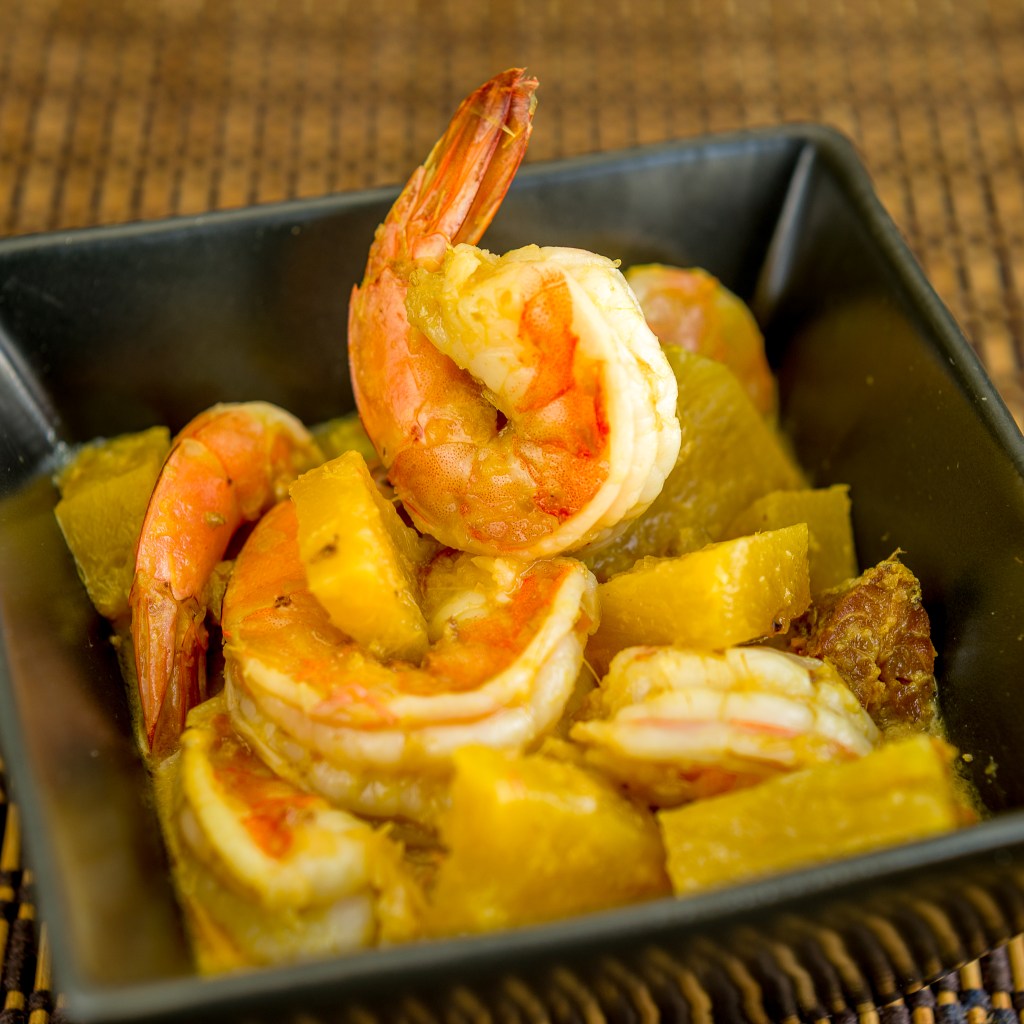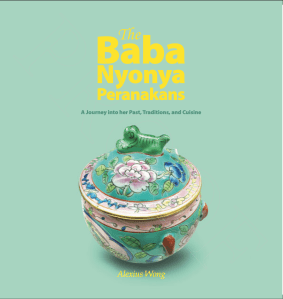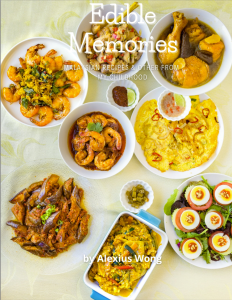
A recent inquiry on a Facebook Baba Nyonya recipe group about memorable Nyonya dishes produced the mention of this amazingly delicious dish, hence my publishing of my grandmother’s recipe.
This signature dish of my maternal grandmother, Madam Leong Yoke Fong, was one of my favorites when I was growing up. It is similar to the Thai version, in which duck is the main ingredient instead of shrimp, but this recipe has a more robust flavor. The sauce used here has a unique combination of flavors: sweet-sourness and fruitiness of the tamarind and pineapple, pungency from the belacan (shrimp paste) and aromatic roots, brininess and depth of flavor from the salted fish, creaminess from the coconut milk, and heat from the chili peppers. It seems nearly impossible that these disparate ingredients could come together harmoniously, but the final result is a wonderful dish that was definitely a gastronomic highlight for my family during our large dinners.
If possible, use freshly cut pineapple to let the fruity and acidic flavors cut through the rich sauce. You may also use canned pineapple chunks packed in its own juice and not in syrup. You can find the salted fish in Asian stores, either at room temperature or in the frozen section—use the small imported croakers if you can’t find Malaysian-produced ones.
Popoh (the Cantonese title we used for my maternal grandmother) would be dressed kemban-style while she moved busily around the kitchen preparing our nightly banquets. This was done so her sleeves would not get in the way of prepping and cooking, and so she could keep cool in the hot kitchen. She insisted on cooking this rich seafood curry in an unglazed earthenware pot called a belanga (website – 2nd photo), mixing it with a wooden round spoon worn down to a flat lip. Interestingly, cooking it this way imparted a je ne sais quoi to the dish that can never be replicated when using a metal pot; to this day, I vividly remember the earthy tinge the pot imparted to the dish. I believe taste memory rarely fades, and such is the case with my memory of the wonderful flavors of this dish. I also believe you will be impressed once you try this recipe and taste all the different notes found in this delectable marriage of ingredients and flavors.
Recipe from The Baba Nyonya Peranakans book
Serves 4 to 6
Preparation time: 45 minutes
5 chili boh or Kashmiri dried peppers, or chile puya, stemmed and seeded, or 1 tablespoon paste
4 Finger hot red chili peppers, stemmed and seeded, or 1½ tablespoons paste/sambal oelek
2 lemongrass stalks, white part only, roughly chopped
1.5 centimeters (½ inch) galangal root, peeled, or ¼ teaspoon powder
4 candlenuts, shelled, or macadamia or cashew nuts (optional)
10 small (100 grams/3½ ounces) shallots, peeled, roughly chopped
2.5 centimeters (1 inch) turmeric root, peeled, or ½ teaspoon powder
12 grams/1 teaspoon/1-inch belacan (shrimp paste)
4 tablespoons vegetable oil
1 head coconut shavings, first and second milk pressings extracted separately (¾ cup each), or 1 cup canned thick coconut milk plus ½ cup water
4 or 5 (2-centimeter [1-inch]) pieces dried fish, preferably the bones (Malaysian type or dried croaker)
1½ cups pineapple chunks (medium-size chunks with core removed)
2 or 3 tamarind slices (asam gelugur/keping), or 1 tablespoon tamarind paste mixed with ½ cup hot water and strained
1 teaspoon salt
1 tablespoon sugar
20 medium prawns, unshelled
- Pour enough hot water on dried chilis to cover and soak until they are soft. Drain. Purée in a food processor until they form a smooth paste.
- In the food processor, add the fresh chili peppers, lemongrass, galangal, candlenuts, shallots, turmeric, and belacan and purée into a fine paste. Remove and set aside.
- In a pot on medium-high heat, heat the oil. Add the processed spice paste and fry for 8 minutes until aromatic.
- Add the first-pressing coconut milk slowly, and bring to a simmer; if using canned coconut milk, add it all now. Add the dried fish and pineapple slices, reduce the heat to medium low, and cook, covered, for about 5 minutes.
- If using the second-pressing coconut milk, add it now. Add the tamarind slices or tamarind water. Cover and cook for another 10 minutes.
- Add the salt and sugar, or to taste. Lower the heat and bring to a gentle boil, then cover and cook for 5 minutes. If the sauce gets too thick, add ½ cup water.
- Add the prawns and cook until just done, 2 to 3 minutes. Taste and adjust the seasoning if necessary. Remove the tamarind slices and serve immediately.


The hardcopy and e-book of The Baba Nyonya Peranakans book (1st image) and Edible Memories e-cookbook (2nd image) are available – more information on the Homepage.

Thanks for sharing the recipe 👍💖
LikeLike
You are welcome. Hope you get to try out the recipe.
LikeLike
I remember this dish fondly particularly eaten with lime juice added to the sambal. Invariably one has an extra plate of rice (tambah) because of the tastiness and flavour of the dish.
LikeLike
Thank you for the comment. Yes, it is indeed a mouth-watering dish that deserves an extra portion of rice to accompany it.
LikeLike
My husband couldn’t stand the smell of belachan.. What can I substitue it with? I am a peranakan, but my husband is angmoh. He likes nonya food without belachan, which I think it’s not possible, right?
LikeLike
Hi. I have heard this often since my sisters are married to angmoh’s. I use the Thai wet paste kind, and I would not include it in the rempah frying, but add it when you add the liquids to boil. Another alternative is to use Italian anchovy paste. Hope either one works.
LikeLike
Hi Alex, Could you tell me where can I buy your hardcopy cookbook please? Thanks. Maria
LikeLike
Hi Maria. Thanks for your enquiry. You may find the info at the bottom of this page – look for the green cover book. http://Www.babanyonyaperanakans.org
LikeLike